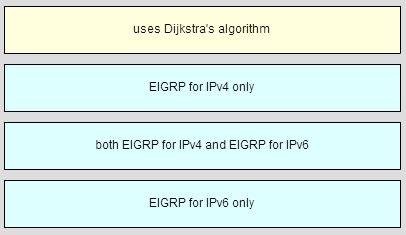CCNA 3 Chapter 7 v5.0 Exam Answers 2015 (100%) PDF Download
-
Which protocol is used by EIGRP to send hello packets?
- TCP
- UDP
- RTP
- IP
-
When an EIGRP-enabled router uses a password to accept routes from other EIGRP-enabled routers, which mechanism is used?
- bounded updates
- partial updates
- EIGRP authentication
- Diffusing Update Algorithm
- Reliable Transport Protocol
-
What is the purpose of using protocol-dependent modules in EIGRP?
- to describe different routing processes
- to identify different application layer protocols
- to use different transport protocols for different packets
- to accommodate routing of different network layer protocols
-
If all router Ethernet interfaces in an EIGRP network are configured with the default EIGRP timers, how long will a router wait by default to receive an EIGRP packet from its neighbor before declaring the neighbor unreachable?
- 10 seconds
- 15 seconds
- 20 seconds
- 30 seconds
-
Which statement describes a characteristic of the delivery of EIGRP update packets?
- EIGRP uses UDP to send all update packets.
- EIGRP sends all update packets via unicast.
- EIGRP sends all update packets via multicast.
- EIGRP uses a reliable delivery protocol to send all update packets.
-
Which destination MAC address is used when a multicast EIGRP packet is encapsulated into an Ethernet frame?
- 01-00-5E-00-00-09
- 01-00-5E-00-00-10
- 01-00-5E-00-00-0A
- 01-00-5E-00-00-0B
-
Why would a network administrator use a wildcard mask in the network command when configuring a router to use EIGRP?
- to lower the router overhead
- to send a manual summarization
- to exclude some interfaces from the EIGRP process
- to subnet at the time of the configuration
-
Refer to the exhibit. Which command should be used to configure EIGRP to only advertise the network that is attached to the gigabit Ethernet 0/1 interface?

- network 172.16.23.64 0.0.0.63
- network 172.16.23.0 255.255.255.192
- network 172.16.23.64 0.0.0.127
- network 172.16.23.0 255.255.255.128
-
Which EIGRP route would have the preferred administrative distance?
- a summary route
- an internal route
- an external route that is redistributed from RIP
- an external route that is redistributed from OSPF
-
Where are EIGRP successor routes stored?
- only in the routing table
- only in the neighbor table
- in the routing table and the topology table
- in the routing table and the neighbor table
-
Which table is used by EIGRP to store all routes that are learned from EIGRP neighbors?
- the routing table
- the neighbor table
- the topology table
- the adjacency table
-
How do EIGRP routers establish and maintain neighbor relationships?
- by exchanging neighbor tables with directly attached routers
- by comparing known routes to information received in updates
- by exchanging hello packets with neighboring routers
- by dynamically learning new routes from neighbors
- by exchanging routing tables with directly attached routers
-
Which command or commands must be entered on a serial interface of a Cisco router to restore the bandwidth to the default value of that specific router interface?
- bandwidth 1500
- shutdown
no shutdown - copy running-config startup-config
reload - no bandwidth
-
Which command is used to display the bandwidth of an interface on an EIGRP-enabled router?
- show ip route
- show interfaces
- show ip protocols
- show ip interface brief
-
A new network administrator has been asked to verify the metrics that are used by EIGRP on a Cisco device. Which two EIGRP metrics are measured by using static values on a Cisco device? (Choose two.)
- bandwidth
- load
- reliability
- delay
- MTU
-
Which three metric weights are set to zero by default when costs in EIGRP are being calculated? (Choose three.)
- k1
- k2
- k3
- k4
- k5
- k6
-
Refer to the exhibit. R2 has two possible paths to the 192.168.10.4 network. What would make the alternate route meet the feasibility condition?

- a reported distance less than 3523840
- a reported distance greater than 41024000
- a feasible distance greater than 41024000
- an administrative distance less than 170
-
What is indicated when an EIGRP route is in the passive state?
- The route has the highest path cost of all routes to that destination network.
- The route must be confirmed by neighboring routers before it is put in the active state.
- The route is a feasible successor and will be used if the active route fails.
- There is no activity on the route to that network.
- The route is viable and can be used to forward traffic.
-
Refer to the exhibit. Which two networks contain feasible successors? (Choose two.)

- 192.168.71.0
- 192.168.51.0
- 10.44.100.252
- 10.44.104.253
- 10.44.101.252
-
Fill in the blank.
In an EIGRP topology table, a route that is in a/an active state will cause the Diffusing Update Algorithm to send EIGRP queries that ask other routers for a path to this network.
-
Order the precedence in which an EIGRP router would choose the router ID. (Not all options are used.)

-
Match the correct version of EIGRP with the EIGRP features. (Not all options are used.)

-
Open the PT Activity. Perform the tasks in the activity instructions and then answer the question.
Which code is displayed on the web server?
- Done
- EIGRP
- Complete
- IPv6EIGRP

Great! I just studying for my CCNA exam and this is very helpful ! Thxs